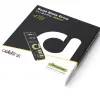Final Words & Conclusion
The Addlink S93 SSD, aimed at the entry-level market segment, incorporates a Maxio MAP1602 controller along with YMTC Xtacking 3.0 3D NAND technology, with a speed of 2400MT/s. This SSD is designed with a DRAM-less configuration and utilizes the M.2 2280 interface standard. It is offered in storage capacities of 1TB, 2TB, and a 4TB model which was subject to testing.
Endurance
We've talked about endurance previously; it's the number of times NAND cells can be written before they begin to malfunction. It is sufficient to remark that the values for QLC written (4 bits saved in a single NAND cell) are not particularly good at it. On this point, however, I always like to paraphrase Einstein: "Relativity, my man," he said (somewhat). You can improve endurance by increasing the volume of your NAND. Volume sizes that are larger result in more NAND cells, and more NAND cells result in greater endurance.
The S93 uses TLC written NAND. A 1TB model has 600 TB written capacity, the 2TB model has a proper 1200 TB written capacity for endurance and the 4 TB is set at 2400TB. Now, if a NAND cell fails, it does not necessarily mean that your data is lost. Many algorithms are constantly monitoring and managing your data; for example, if a cell's lifetime is about to expire, the bits inside that cell will be relocated to a more healthy cell. So how long does a storage unit last before NAND flash cells go the way of the dodo? Well, if you are a really extreme user, you might be writing 50 GB per day (really, normal users probably won't even write that per week), but based on that value, 50GB x 365 days = 18.25 TB per year written. You get 1200 TBW (for a 2TB model), so that's almost 66 years of usage and half that for the 1 TB SSD version. Let me make it very clear, 50 GB per day each day of the year is a very ambitious number.
Performance
In terms of performance, the Addlink S93 solid-state drive (SSD) competes effectively in the market across standard performance traces and sustained workload conditions. While the SSD demonstrates commendable performance in synthetic benchmarks, these metrics may not fully represent its real-world performance. In practical applications, the SSD sustains its efficiency, with only marginal differences when compared to its rivals. Although it does not top the performance charts, its read and write speeds of up to 6 GB/s remain noteworthy. Trace testing reveals very decent performance, particularly in random 4K IOPS queues. The SSD also exhibits dependable performance during sustained write activities.
When subjected to a 100% load write burst to assess linear performance, the SSD maintains a consistent It was able to perform linear writes to about 25% of its full capacity before any noticeable performance degradation occurred. In quantitative terms, this equates to a sustained writing speed of approximately 5000 MB/s over a continuous 1TB of data transfer. That is more than sufficient for the demands of a gaming PC workload.
Concluding
Performance evaluations of the Addlink S93 SSD indicate modest Gen 4x4 results, particularly when compared with top-performing consumer SSDs. Nonetheless, the SSD manages to impress me. We applaud companies for trying out controllers other than Phison, as in recent years the brand has gotten too dominant monopolizing the entire M.2 NAND storage sector, artificially inflating prices upwards, and let's face it, their PCie GEn 5.0 controllers simply overheat. The market needs competition to remain healthy. That said, the Maxio MAP1602 controller certainly did not disappoint as it performs just as well as the competition (at much better prices).
The HMB design certainly isn't something to shy away from, a small part of your system memory (48~64MB)is used as opposed to a DRAM chip on the SSD. Despite the performance in most benchmark tests is run of the mill for PCIe Gen 4.0, the pricing of the Addlink S93 makes this product very competitive The SSD is currently priced at approximately $199 for the 4TB version, positioning it as an accessible option for users with less demanding storage needs. In performance terms, the Addlink S93 occupies the high-end ground at top-tier PCIe Gen3 and mainstream Gen4 drives, with the specific performance dependent on various factors such as workload. As a PCIe Gen 4 drive, the SSD uses TLC flash memory, rather than QLC NAND flash memory, offering a cost-effective option compared to comparable products like the WD Black. Compared to Gen5 products your typical workloads perform roughly the same. Yes, despite variability in performance, the Addlink S93 demonstrates peak write sequential performance with CrystalDiskMark write speeds consistently surpassing the 6000MB/s range and read speeds reaching beyond 7000MB/s. Small queue depth 4K random numbers are slightly more modest. This SSD performs exceptionally well under most conditions, reaching high-end-class NVMe performance on specific workloads. Addlink also provides a five-year warranty. The drive is available in three capacities: 1TB, 2TB and 4TB.
During our review, the Addlink S93 positioned itself is a worthy mainstream PCIe Gen 4.0 SSD, it consistently performed well and easily can be used as a game PC SSD or something for longer-term yet cheaper storage. NAND prices are currently volatile and trending downward, often completely different from street prices in detail, however at 5 cents per GB for the $99 2TB and $199 4TB models certainly hits a sweet spot.
Recommended Downloads
- Sign up to receive a notification when we publish a new article
- Or go back to Guru3D's front page.




